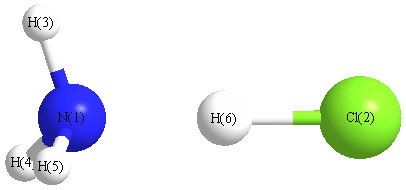Vibrational Frequencies calculated at HF/6-31G**
| Mode Number |
Symmetry |
Frequency
(cm-1) |
Scaled Frequency
(cm-1) |
IR Intensities
(km mol-1) |
Raman Act
(Å4/u) |
Dep P |
Dep U |
|---|
| 1 |
A1 |
3705 |
3344 |
3.95 |
106.93 |
0.04 |
0.07 |
| 2 |
A1 |
2759 |
2490 |
1079.22 |
364.32 |
0.37 |
0.54 |
| 3 |
A1 |
1217 |
1099 |
202.86 |
1.13 |
0.02 |
0.04 |
| 4 |
A1 |
179 |
162 |
10.42 |
0.47 |
0.41 |
0.59 |
| 5 |
E |
3842 |
3468 |
11.31 |
58.81 |
0.75 |
0.86 |
| 5 |
E |
3842 |
3468 |
11.31 |
58.81 |
0.75 |
0.86 |
| 6 |
E |
1805 |
1629 |
27.63 |
9.94 |
0.75 |
0.86 |
| 6 |
E |
1805 |
1629 |
27.63 |
9.94 |
0.75 |
0.86 |
| 7 |
E |
702 |
634 |
98.87 |
1.60 |
0.75 |
0.86 |
| 7 |
E |
702 |
634 |
98.87 |
1.60 |
0.75 |
0.86 |
| 8 |
E |
244 |
221 |
21.56 |
5.25 |
0.75 |
0.86 |
| 8 |
E |
244 |
221 |
21.56 |
5.25 |
0.75 |
0.86 |
Unscaled Zero Point Vibrational Energy (zpe) 10523.5 cm
-1
Scaled (by 0.9026) Zero Point Vibrational Energy (zpe) 9498.5 cm
-1
See section
III.C.1 List or set vibrational scaling factors
to change the scale factors used here.
See section
III.C.2
Calculate a vibrational scaling factor for a given set of molecules
to determine the least squares best scaling factor.
Charges, Dipole, Quadrupole and Polarizability
Charges from optimized geometry at HF/6-31G**
Charges (e)
| Number |
Element |
Mulliken |
CHELPG |
AIM |
ESP |
| 1 |
N |
-0.821 |
|
|
|
| 2 |
Cl |
-0.282 |
|
|
|
| 3 |
H |
0.291 |
|
|
|
| 4 |
H |
0.291 |
|
|
|
| 5 |
H |
0.291 |
|
|
|
| 6 |
H |
0.230 |
|
|
|
Electric dipole moments
Electric dipole components in Debye
(What's a Debye? See section
VII.A.3)
| |
x |
y |
z |
Total |
| |
0.000 |
0.000 |
-4.615 |
4.615 |
| CHELPG |
|
|
|
|
| AIM |
|
|
|
|
| ESP |
|
|
|
|
Electric Quadrupole moment
Quadrupole components in D Å
| Primitive |
|---|
| | x | y | z |
|---|
| x |
-20.046 |
0.000 |
0.000 |
| y |
0.000 |
-20.046 |
0.000 |
| z |
0.000 |
0.000 |
-14.733 |
|
| Traceless |
|---|
| | x | y | z |
|---|
| x |
-2.657 |
0.000 |
0.000 |
| y |
0.000 |
-2.657 |
0.000 |
| z |
0.000 |
0.000 |
5.313 |
|
| Polar |
|---|
| 3z2-r2 | 10.627 |
|---|
| x2-y2 | 0.000 |
|---|
| xy | 0.000 |
|---|
| xz | 0.000 |
|---|
| yz | 0.000 |
|---|
|
Polarizabilities
Components of the polarizability tensor.
Units are
Å
3 (Angstrom cubed)
Change units.
| |
x |
y |
z |
| x |
2.210 |
0.000 |
0.000 |
| y |
0.000 |
2.210 |
0.000 |
| z |
0.000 |
0.000 |
3.755 |
<r2> (average value of r
2) Å
2
| <r2> |
84.352 |
| (<r2>)1/2 |
9.184 |
